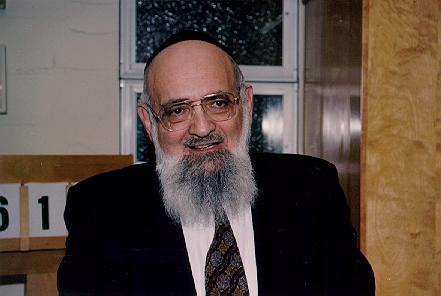 This past Wednesday evening (after bringing Rena home from the hospital with a new baby), I traveled to Beit Shemesh for an azkarah marking the Shloshim of Rabbi Gedalia Anemer, who was both the rav of the shul I grew up in and my rebbe during my last two years of high school.
This past Wednesday evening (after bringing Rena home from the hospital with a new baby), I traveled to Beit Shemesh for an azkarah marking the Shloshim of Rabbi Gedalia Anemer, who was both the rav of the shul I grew up in and my rebbe during my last two years of high school.My good friend Rabbi Dov Lipman (and classmate and teammate on the basketball team and coeditor of the yearbook - it was a small school) organized the program (a big yasher koach to him) and asked me to speak.
Rabbi Anemer's drashot - especially Shabbat Shuvah and Shabbat Hagadol, were legendary - almost a taste of a world long gone. He divided his drashot into two: the first half was pure pilpul - in-depth halachah that focused on a specific detail or nuance in Jewish law. It was so detailed, that in high school we used to joke about how long we could follow him: "I lost his at 22 minutes, how long did you keep up?" But then, after about half an hour, he switched gears into mussar, and inspiration. His rhetoric soared; he inspired and cajoled, lifted us to places we didn't normally rise to. But I always wondered: as a rabbi, I also gave drashot on Shabbat Shuvah and Shabbat Hagadol. But I only gave the second half - the mussar and inspiration and drush. I could never really get away with giving the first half. Why did he, throughout all the years, continue to give both halves of his drashah? Why the first half of halachic nuance?
To answer this question, I noted that the Torah calls the men named to serve as leaders of the tribes by the term "nesi'im - נשיאים. We normally translate this word to mean "princes," but the word emanates from the Hebrew word, לנשוא - to lift up. I suggested that the nesi'im played dual roles. On the one hand, they had to inspire the people - to show them the possible. But then, on the other hand, they also had to be nosei - to literally carry the people as well.
Rabbi Anemer was both: first and foremost, he was the ultimate role model. He represented an idea and an ideal. He stood for uncompromising Torah values, to the very last nuance and detail. But at the same time he lifted us up, sometimes on his shoulders. He carried the burden of his community with grace and dignity.
Something at the shloshim struck me. When my father died at a very young age, Rabbi Anemer played an instrumental role in our family, and also in my personal development. I always felt a personal, almost intimate connection to him, even though we did not often speak. At the shloshim, I realized that I was not alone. So many other people felt exactly the same way. He somehow found a way to connect to so many of his students and community members. I thought I knew a secret about him - that behind the facade of strength and fire and brimstone, lay a gentle, genteel giant of a man.
I realized this week that it's not really a secret. Everyone who knew him well understood the power he had to love each and every one of us. And therein lay his greatness.
I miss him already.

No comments:
Post a Comment
Comments transform a blog into a community. Please join.